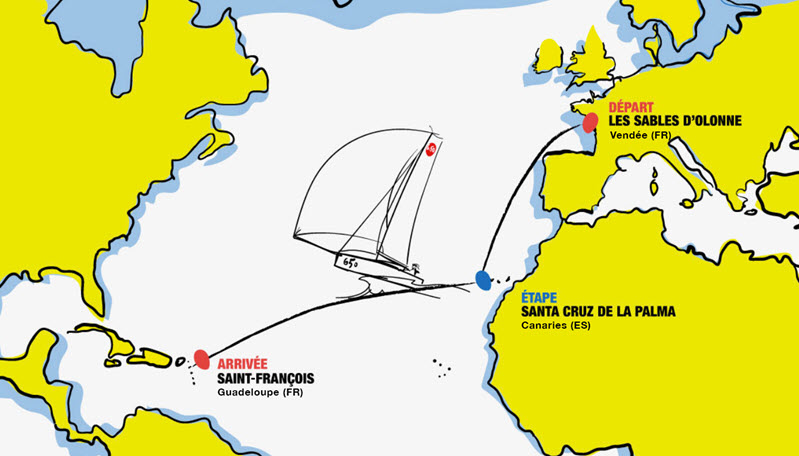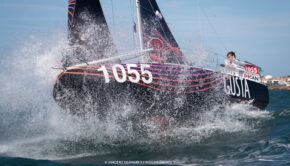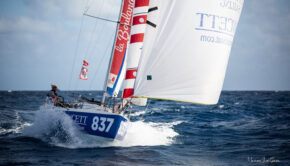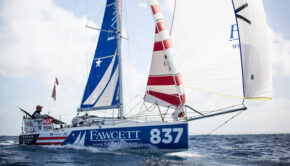Light winds forecast for Mini Transat
Published on October 27th, 2021
The second half of the 23rd Mini Transat EuroChef starts October 29 for the 87 solo sailors still competing, with the final stage to set sail from Santa Cruz de La Palma (Canary Islands) bound for Saint-François (Guadeloupe) located some 2,700 miles away on the other side of the Atlantic.
Though it took between 12 and 13 days for the front runner to complete the passage from the Canaries to the West Indies during the last edition in 2019, the trend which seems to be playing out for the Mini 6.50s is not looking quite as quick this year.
The reason for this is that the trade wind is currently ranging from very weak to virtually not existent. As such, the solo sailors will be forced to drop a very long way south in a bid to hook onto more pressure whilst also extending their courses. In this way, the leaders in the prototype and production categories are set to take between 14 and 16 days to complete the distance. This naturally implies a few minor adjustments, particularly regarding the quantities of water and food carried aboard.
“It’s not easy because you need to be as light as possible to extricate yourself from the high pressure and also anticipate the fact that it’s going to be long,” explains Victor Turpin (850 – Pays d’Iroise). “You really have to mull things over, especially as you also have to bear in mind how it will pan out if things take a turn for the worse or it lasts longer than forecast.”
The light wind is due to a zone of high pressure positioned a long way south and low pressure systems rolling around between the Azores and the Canaries. As a result, the famous NE’ly breeze which is normally so constant in this section of the Atlantic is absent around the Spanish archipelago and is very weak further south.
Turpin plans to carry 90 litres of water, which is the minimum amount permitted within the requirements set out by the Sailing Instructions, which has an upper limit of 140 litres. “I’m reckoning on 3 litres a day to keep me in good shape, but I prefer to have a bit of leeway in case one of my containers gets a hole in it for example.”
Tenth at the end of the opening stage, he’s still targeting a Top 5 spot in Guadeloupe and to achieve that he knows that one of the keys is finding the best possible compromise between weight/performance. A ratio that’s likely to weigh heavily on the minds of the skippers during the first 36 hours of racing through the light patch.
“Being loaded down and hence a bit heavy can really be a game changer in conditions like these, which is a bit grim,” Turpin explains. “You get the impression that those sailors who manage to extract themselves from the light conditions the quickest and are first to hook onto the steadier trade wind will really extend away from the rest of the fleet.
“In the prototype category, we’ve already had a taste of that in the first leg, shortly before we rounded Cape Finisterre. The first four boats made good their escape and the others were pinned to the racetrack. We don’t fancy another episode like that.”
Currently lying in 4th place in the production boat category, Jean-Marie Jézéquel (951 – FondApro) shares his apprehension. “The first few hours of racing are very likely to be pretty crucial. We’re going to have to be right on top of our game to sniff out the slightest gusts and it’s imperative we don’t miss our connection.
“I’m also going to set sail with 90 litres of water. I’m taking 15 days of food and a bit extra, given that when it’s hot, which should be the case during this section of the course, you consume a lot fewer calories than normal.”
In this regard, everyone seems to have different ‘tactics’, as Tanguy Aulanier (896 – La Chaîne de l’Espoir) explains: “There are plenty of philosophies. On a personal level, I’m always a bit stressed about being without. I’ve often heard Yves Le Blévec (winner of the Mini Transat 2007 and skipper of Actual Ultim) say that food was a pointless weight to have aboard. It’s fair to say that in the Mini 6.50 we’re pretty much of that mindset.
“Furthermore, for me, when I’m on the water and bored during a period of calm, I tend to want to eat a lot”, points out the sailor, who is therefore planning on taking between 20 and 22 days of food, which naturally affects how he organizes things on his boat.
The more water and food there is, the greater the weight aboard the boat while stowage inside the Mini ends up being modified and you also need to think about stacking.
“It takes a lot of effort to shift all the containers and all the bags every time you gybe. As a result, I’m limiting myself to 90 litres, the minimum permitted,” says Hugo Lauras (512 – YC Crouesty Arzon), who could well excel thanks to his Pogo 2 and his dinghy sailing experience in the light airs of the first few miles.
“I’m telling myself that if I manage to do well at exiting the Canaries archipelago, I can run with that”, explains Lauras who is planning to take 20 to 25 days for this second leg. “Ultimately, what scares me most is monotony, the days repeating themselves over and over. It’ll be important to bear in mind that the start will be long and not to get frustrated from the get-go.”
Race details – Entry list – Tracker
After a one day postponement, the 23rd edition of the Mini Transat, reserved for the Mini 6.50, the smallest offshore racing class at 21-feet, got underway on September 27, 2021.
A notable proving ground for sailors with shorthanded aspirations, it is also test platform for new boat types, with 65 competitors entering in the production division for manufactured boats while the prototype division has 25 entrants with custom designs.
Held biennially, with limited participation for safety that includes strict qualification guidelines, the 4,050 nm course is divided in two parts: Les Sables d’Olonne (France) to Santa Cruz de La Palma in the Canaries (Spain), restarting on October 29 for the finish at Saint-François in Guadeloupe.
Source: Mini Transat










 We’ll keep your information safe.
We’ll keep your information safe.